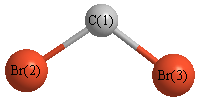Jump to
S2C1
Energy calculated at MP2/cc-pVDZ
| | hartrees |
|---|
| Energy at 0K | -5182.897201 |
| Energy at 298.15K | -5182.902245 |
| HF Energy | -5182.520342 |
| Nuclear repulsion energy | 326.160471 |
The energy at 298.15K was derived from the energy at 0K
and an integrated heat capacity that used the calculated vibrational frequencies.
Geometric Data calculated at MP2/cc-pVDZ
Point Group is C2v
Cartesians (Å)
| Atom |
x (Å) |
y (Å) |
z (Å) |
|---|
| C1 |
0.000 |
0.000 |
0.998 |
| Br2 |
0.000 |
1.553 |
-0.086 |
| Br3 |
0.000 |
-1.553 |
-0.086 |
Atom - Atom Distances (Å)
| |
C1 |
Br2 |
Br3 |
| C1 | | 1.8933 | 1.8933 |
Br2 | 1.8933 | | 3.1050 | Br3 | 1.8933 | 3.1050 | |
 More geometry information
More geometry information
Calculated Bond Angles
| atom1 |
atom2 |
atom3 |
angle |
|
atom1 |
atom2 |
atom3 |
angle |
| Br2 |
C1 |
Br3 |
110.167 |
|
Electronic energy levels
Charges, Dipole, Quadrupole and Polarizability
Jump to
S1C1
Energy calculated at MP2/cc-pVDZ
| | hartrees |
|---|
| Energy at 0K | -5182.878097 |
| Energy at 298.15K | -5182.883153 |
| HF Energy | -5182.535721 |
| Nuclear repulsion energy | 315.439081 |
The energy at 298.15K was derived from the energy at 0K
and an integrated heat capacity that used the calculated vibrational frequencies.
Geometric Data calculated at MP2/cc-pVDZ
Point Group is C2v
Cartesians (Å)
| Atom |
x (Å) |
y (Å) |
z (Å) |
|---|
| C1 |
0.000 |
0.000 |
0.733 |
| Br2 |
0.000 |
1.663 |
-0.063 |
| Br3 |
0.000 |
-1.663 |
-0.063 |
Atom - Atom Distances (Å)
| |
C1 |
Br2 |
Br3 |
| C1 | | 1.8436 | 1.8436 |
Br2 | 1.8436 | | 3.3263 | Br3 | 1.8436 | 3.3263 | |
 More geometry information
More geometry information
Electronic energy levels
Charges, Dipole, Quadrupole and Polarizability
